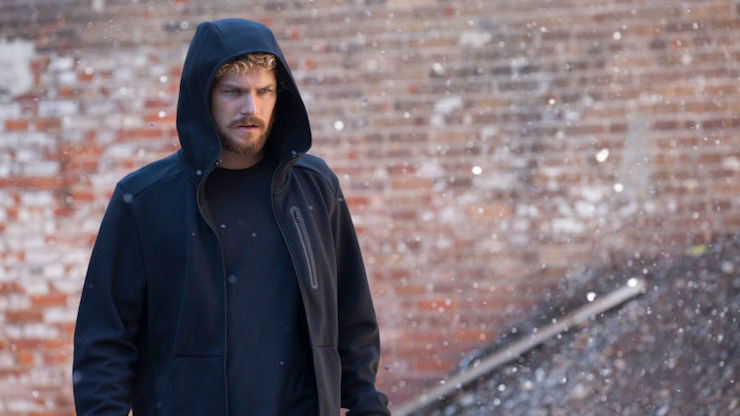After watching the first three episodes of Iron Fist, my initial impressions were that Finn Jones was engaging and mostly harmless in the title role, that Colleen Wing as played by Jessica Henwick was a breakout character with whom you do not mess, and that the show started out as an unfocused mess.
Well, ten episodes later, and the first two impressions are soured, and the third has held true, sadly.
This is not to say that season one of Iron Fist is a complete disaster, but it is the least of Marvel’s Netflix offerings so far, and there are three primary culprits—the treatment of the lead character is a scattershot mess, the show can’t make up its mind who the villain is, and there’s very little fun to be had.
SPOILERS AHEAD FOR IRON FIST SEASON ONE
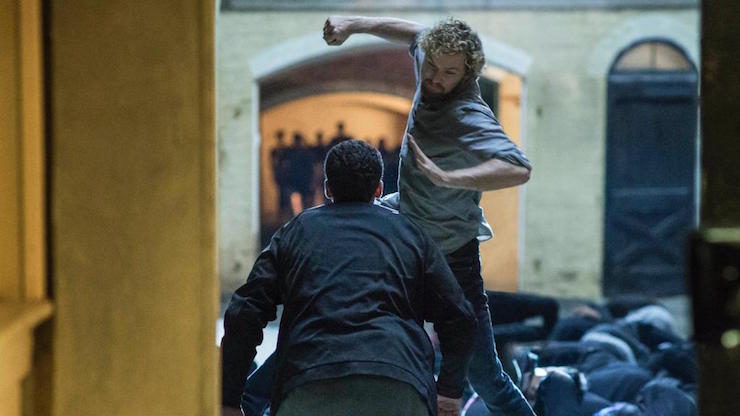
Here’s the biggest issue with Iron Fist: this is a character whose entire raison d’être is that he’s the living weapon, a superhero whose primary MO is martial arts (with the added bonus of the occasional glowy fist). The character was specifically created to cash in on the kung-fu craze of the 1970s that was spearheaded by Bruce Lee’s overwhelming popularity.
So you’d think the martial arts aspect would be better represented. The fight choreography is remarkably pedestrian and ordinary. We got better fight scenes in Daredevil—hell, we get better fight scenes in Agents of S.H.I.E.L.D. Finn Jones didn’t have any martial arts training prior to being cast in this role, and it shows. At times, he moves very well, at other times he looks awkward and ridiculous. At no point does he carry himself in a manner that suggests that he’s a living weapon.
A perfect example: in episode 6, one of his three fights is against Scimitar (based on a villain who debuted in the first Iron Fist comics series) played by David Sakurai. At one point, Danny retreats. That part is fine, but he does so by turning his back on Scimitar and running into the next room with all the catwalks.
At that point, I’m screaming at the screen. I teach a kids sparring class every week at the dojo where I train, and one of the things I’m constantly telling the kids is never to turn your back on your opponent. You need to keep your eye on the person trying to hurt you as much as is humanly possible. That goes double if the opponent is carrying a big-ass blade in his hand. This is basic Sparring 101 stuff, and the fight choreographers couldn’t even get that right.
Sakurai is a trained martial artist, which also is part of the problem. Iron Fist is the living weapon, the greatest hand-to-hand fighter in the Marvel Universe. In the MCU, we’ve seen other folks do acrobatic hand to hand: Captain America in five movies, the Black Widow also in five movies, Melinda May and Daisy Johnson in Agents of S.H.I.E.L.D., Daredevil and Elektra in Daredevil, and Scimitar, Davos, Zhou Cheng, and Colleen Wing right here in Iron Fist, and all of them are more impressive visually, and all of them give the impression that they could kick Danny’s ass.
This is especially noticeable in episode 6, when the only time Danny looks impressive against Scimitar is when his stunt double is obviously being used, in episode 8 when Lewis Tan’s Zhou Cheng runs rings around Danny with his drunken master act, and in episode 12 when Danny and Colleen do forms together and she looks about fifty times more elegant than he does.
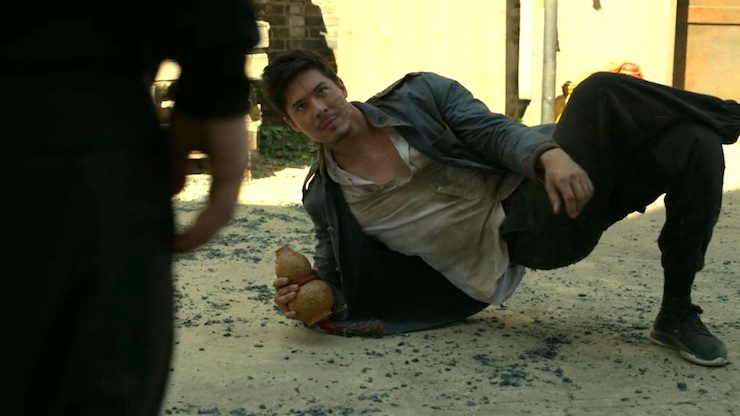
(Tan’s mix of drunken stumbling, drinking, and fighting was a delight to watch, one of only two bits of fight choreography I actively admired in the series, the other being Colleen’s swordfight in the same episode. Not coincidentally, that one was the only episode directed by Kevin Tancharoen, who has also directed the episodes of Agents of S.H.I.E.L.D. that have had the most effective action sequences. One wishes he’d been used more.)
The writing also continues to show ignorance of differing martial arts styles, in particular that Chinese and Japanese traditions are very different. Madame Gao is Chinese, yet the Hand that we’ve seen in Daredevil and here seem to be students of Japanese martial arts (ninjitsu in Daredevil, karate and kanjutsu here). Davos specifically says that they trained in kung fu in K’un L’un, a city that only intersects with Earth every fifteen years, yet he lectures Danny on the protocol Colleen must follow as she fights her sensei, protocols that are Japanese in origin. It wouldn’t bother me so much if Davos wasn’t from an interdimensional city—where did he even learn the term sensei if he’s only studied kung fu in another dimension?
One could, perhaps, forgive this if other aspects of Jones’s performance made up for it, but the script can’t even seem to make up its mind who Danny is. For someone who has been away from civilization for fifteen years, he assimilates back into the world remarkably quickly. He doesn’t seem to have any trouble with anything in 2017 even if it’s something that wasn’t around in 2002 (like cell phones with GPS that are easily trackable) or that he shouldn’t know how to do given that he was ten years old when he went to K’un L’un (like being able to drive, which he does twice without any difficulty). We first see him barefoot and not caring about his appearance, but he assimilates to clothes (and shoes) almost instantly.
Supposedly he’s been trained in how to center himself and control his anger (Davos even says as much to Claire), yet he constantly is flying off the handle. Either he wants to fulfill his duty as the Iron Fist to stop the Hand or he wants to be Danny Rand, billionaire, again or maybe he wants to protect his friends, or—I dunno. His motivations change from episode to episode, sometimes within the same episode. At one point, he speechifies to Colleen about how they need to stop just destroying, making you think he finally started listening to Claire, but then he does nothing to follow up on that revelation. He spends most of the first three episodes having the same flashback to the plane crash, and then his PTSD is pretty much forgotten until the final two episodes.
The first three episodes gave the impression that Colleen wandered in from a different, more interesting show, and points to the writers for actually tying her story closer to Danny’s by making her part of a different faction of the Hand, but those points get taken away because it makes Colleen look like an idiot. Worse, it makes her dojo much less interesting, as it’s just a training ground for the Hand, something that you’d think would have been mentioned sooner in one of her non-Danny scenes. As it is, the revelation comes out of left field and doesn’t completely track with the earlier portrayals of Colleen. (The cage-fighting aspect is also dropped like a hot potato, making it obvious that they were put there to show off Jessica Henwick’s skills, another element that highlights Jones’s inadequacy.) Which is too bad, as despite this misstep, Henwick remains one of the series’ bright spots.
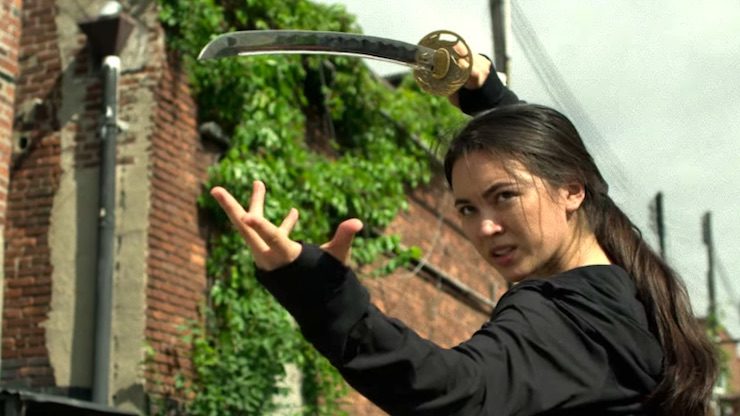
But a misstep it is. The entire Hand compound run by Bakuto just screams “cult!!!” so much so that Danny points it out. Henwick’s portrayal of Colleen is completely off-kilter and wrong while she’s in the compound, and doesn’t right itself until she rejoins Danny at Claire’s place. Plus Ramon Rodriguez plays Bakuto with such oily sliminess that you wonder how anyone could fall for his act.
Rodriguez is one of the more disastrous casting decisions of the show, as his Bakuto is unconvincing in pretty much every mode. He’s not menacing when he’s being evil (the scene where he double crosses Ward and shoots Joy is almost laughably pathetic), neither his martial arts skills nor his swordfighting skills are all that and a bag of chips (his climactic duel with Colleen at Bethesda Fountain in episode 12 was probably filmed in the rain to help cover Rodriguez’s shortcomings), and he doesn’t have the charm to pull off Bakuto’s cover as a benevolent leader.
And he points out another of the show’s troublesome issues: a plethora of villains, only one of whom is actually effective as such.
At first, we think the primary antagonists are the Meachum family, who are opposed to our hero. We’ve got Joy, who objects to Danny’s stalkerish tendencies early on (not, I might add, without reason), we’ve got Ward, who’s slimy and also a pill popper, and we’ve got Harold, who’s vicious and nasty and faked his own death and works for the Hand. Attempts are made to give the characters nuance, but where that worked in Daredevil with Fisk and Elektra and in Luke Cage with Cottonmouth, it comes with no context or sense here. Joy is mostly portrayed as a good person, yet we see her manipulate the organ donor list and screw over families with cancer—and then at the end plots with Davos to kill Danny (more on that in a bit). Ward is sometimes a victim, sometimes a bastard, sometimes an ally, and the threads get stripped, he changes gears so often without rhyme or reason. (Having said that, Tom Pelphrey does an excellent job portraying Ward’s addiction and withdrawal, as well as his frustration with being under his father’s thumb.)
And then we have Harold. Does he love his children? Is he a bastard? Is he losing his soul? Why do we wait until thirteen episodes in to find out he caused the plane crash? (More on that in a bit, too.) I was actually grateful when Ward killed him in episode 7 (it was a great moment for Ward and I thought it meant we’d be saved from the most disappointing performance I’ve ever seen the usually reliable David Wenham give), and my response to his coming back to life at the top of episode 9 was mostly just annoyance.
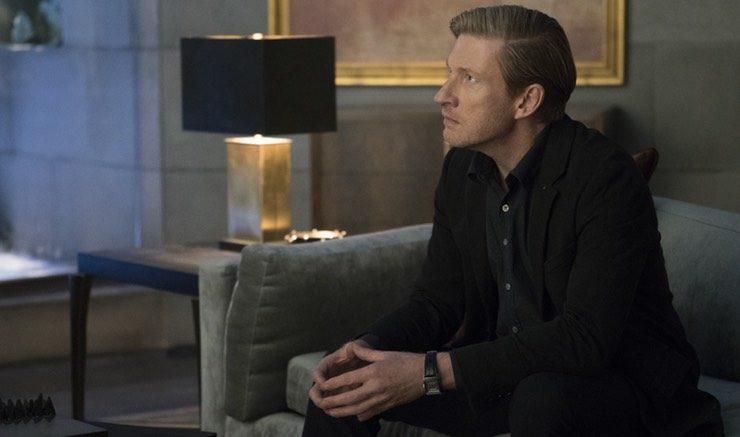
Then we think it’s Madame Gao, then we think it’s Bakuto, and in the end we circle back ’round to Harold. And only Gao is an actual effective villain in all this. Wai Ching Ho continues her superlative work first seen in Daredevil, and we get more hints to her longevity and effectiveness. (I still hold true to my personal theory that she’s a dragon. Maybe she’s Shou Lao’s mother!) For all that the villain-taunts-the-heroes-while-captured thing has been a tired cliché since The Silence of the Lambs in 1991, it can be very effective, especially when the villain is played by someone as superb as Ho. (See also The Avengers, when Tom Hiddleston, Samuel L. Jackson, and Scarlett Johansson made it work magnificently.) Gao is so obviously operating on a whole different level than everyone else—yet she still is vulnerable, it’s just a lot harder to find those vulnerabilities. (Danny actually scores two victories against her, stealing the tablet, and getting her captured, but these are both minor battles—Gao’s still winning the war.)
Sadly, Gao is also the villain who gets the least screen time, and Iron Fist is the poorer for it.
We do get one more last-minute villain, and it’s a heel-turn that readers of the comics could have predicted, but which people who don’t know the comics couldn’t have, because it’s very poorly set up: Davos.
In the comics, Davos (a.k.a. the Steel Serpent) was the son of Lei Kung, the Thunderer, who was also Danny’s teacher. That much holds true in the series, but instead of Davos hating Danny and challenging him for the iron fist, here Davos is Danny’s best friend (basically merging the comics’ Davos with Conal, in much the same way Captain America: The First Avenger merged the Bucky of the comics with Arnold Roth to form the MCU Bucky), who chases after him to New York, not to challenge him and take the iron fist away as in the comics, but instead to bring him home to fulfill his duty to K’un L’un. (In the MCU, Iron Fist’s duty is to physically guard K’un L’un from attack by outsiders, particularly the Hand.) They argue about this a lot in the final episodes, but the leap from that to Davos plotting to kill Danny with Joy is too long, too far, and too fast.
Which is too bad, as Sacha Dawan is another of the high points of this series. In particular, he actually moves like a trained martial artist far better than Jones does, which is put into sharp relief when they’re fighting back to back in episode 10. (Dawan’s background is as a dancer, not a martial artist, but for the purposes of television fight choreography, it works. Also, some of the finest martial artists I’ve trained with had dancing backgrounds before they joined our dojo.) Indeed, I find myself wishing I lived in the alternate universe where Dawan was cast in the title role.
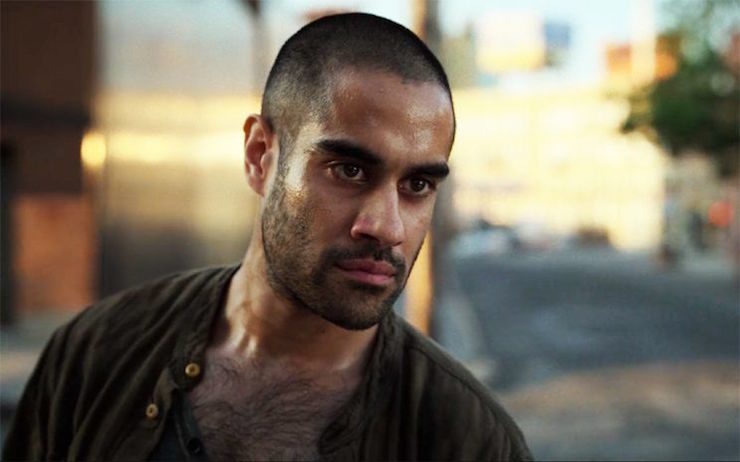
This series is more or less an adaptation of Iron Fist’s earliest days in the comics, as this storyline is a distillation (and modernization) of Marvel Premiere #15-24, Iron Fist #1-15, and Marvel Team-Up #63-64, which were published from 1974-1977. I mention this because those comics understood certain storytelling aspects that the writers of this series completely fumbled. In Marvel Premiere #15, we immediately saw that Harold Meachum killed Wendell Rand, we immediately saw Iron Fist in a major martial arts battle, we saw the iron fist in action. More to the point, we saw K’un L’un—that first story has Danny leaving the city once it’s intersected with Earth once again to claim vengeance on Harold. We saw Danny’s training, and throughout the rest of the issues I mentioned, there are plenty of flashbacks to his time in the city.
In the series, we’re stuck waiting for lots of this stuff, to no good end. The hero-trapped-in-an-insane-asylum story should not be the second episode, when we barely even know the guy. He doesn’t have a proper big-ass fight until episode 3, and he doesn’t have a good one until episode 6, when he challenges Madame Gao to free her heroin chemist’s daughter. (Oh hey, after thirteen episodes, that heroin is still on the streets, and our theoretical hero has managed not to do a single thing about it. Nice going…) We don’t even see the iron fist until the end of episode 2.
Worst of all, we never see K’un L’un. The PTSD flashbacks in the first few episodes are setting up to see more as the series goes on, but we see precious little—just Danny and Davos outside Shou Lao’s cave and Danny and Davos standing guard outside the city. An image of Lei Kung narrates platitudes throughout Danny’s challenge in episode 6, but we never see the real thing (which is too bad, as Hoon Lee plays him with impressive gravitas). The only element of Danny’s training we actually see is him being conditioned with staffs. We don’t see his confrontation with Shou-Lao the Undying that gives him the iron fist, only its aftermath. (That, at least, was likely budgetary, as a dragon is probably a bit too expensive for Netflix…)
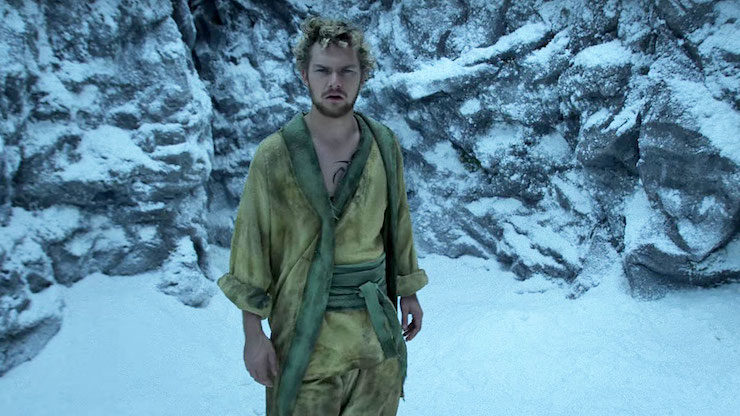
Instead, we spend way too much time on Rand Enterprises, which would be fine if this were a drama on TNT or USA rather than a show about a superhero. Every time we cut back to the Meachums, I was twiddling my thumbs waiting for the interesting stuff to come back, especially since the Rand connection to the rest of the storyline was paper-thin and only occasionally relevant.
Danny’s motivations for returning to New York are left maddeningly unclear and inconsistent. Since he doesn’t even find out that the plane was sabotaged until late in the series, it isn’t vengeance—especially since he’s buddy-buddy with Harold right up until the latter frames him for drug dealing.
Ultimately, the first season of Iron Fist feels like the rough draft of a storyline that needs at least three or four rounds of revision to tighten it up. It’s the story of a martial arts superhero made by people who don’t know enough about martial arts and who cast a non-martial artist in the role. Worse, it’s a story about a superhero who’s barely a hero. Daredevil and Luke Cage were both about doing the right thing and helping people. Jessica Jones was more inwardly directed, but the overall emphasis was overcoming an assault and stopping a bad person. Iron Fist ultimately is lacking in a proper heroic element—instead it’s about a dumb kid who stumbles through several adventures without actually doing a whole helluva lot of good. Colleen goes on a more interesting journey than he does.
The biggest problem, though, is the severe lack of fun here. While both seasons of Daredevil and the first seasons of Jessica Jones and Luke Cage all had their extremely heavy moments, they also had their fun bits, times when you laughed out loud. The hallmark of the MCU since Robert Downey Jr. snarked his way through Iron Man in 2008 has been that these stories always have a sense of fun to ameliorate the heavy stuff.
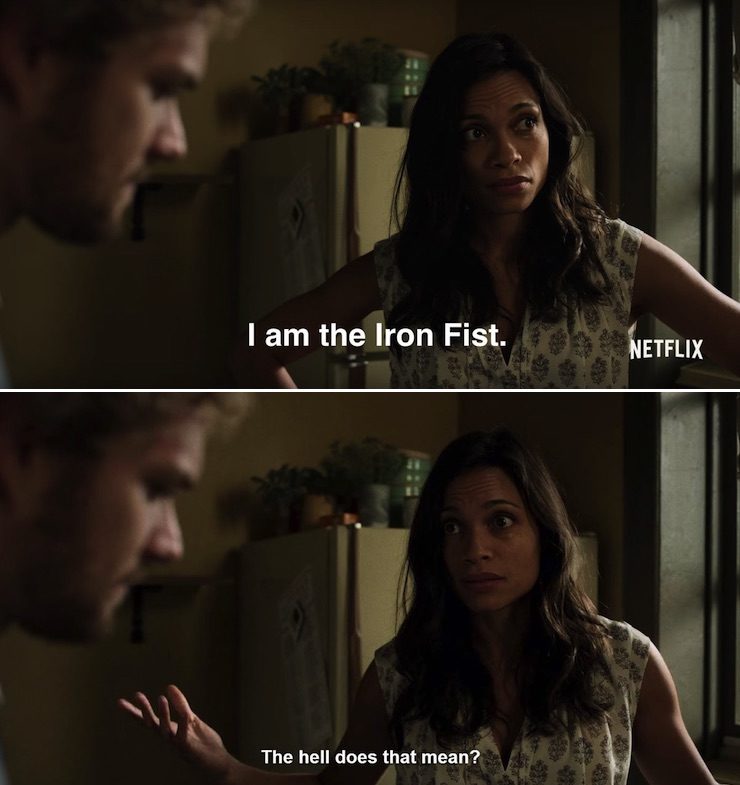
The only time we get that in Iron Fist is when Rosario Dawson’s Claire Temple is on screen. She remains a delight and a joy, and continues her excellent role as the glue that holds the Netflix series together. (She’s also the source of many of the continuity hits, as her bad experiences with the Hand in Daredevil season 2 are directly referenced, plus she reads a letter from Luke Cage in Seagate Penitentiary and gives Danny one of Luke’s old bullet-ridden shirts. Though they’re not the only ones—besides the appearance of Carrie-Anne Moss’s Jeri Hogarth, we’ve got Joy hiring a private investigator who is strongly implied to be Jessica Jones, Danny giving a story to reporter Karen Page, and more than one reference to “the incident” in The Avengers.) The lack of comic relief makes the entire series a major slog.
Iron Fist is a character with more than four decades of history in the comics. He deserved better than this. Let’s hope that season 2 and The Defenders do better by him.
Keith R.A. DeCandido is a second-degree black belt in karate and the author of several bits of prose based on Marvel’s heroes. The latter includes two Spider-Man novels, short stories starring Spidey, the X-Men, the Hulk, and the Silver Surfer, and the recent “Tales of Asgard” trilogy: Thor: Dueling with Giants, Sif: Even Dragons Have Their Endings, and the forthcoming Warriors Three: Godhood’s End. His latest project is Mermaid Precinct, the fifth novel in his acclaimed fantasy police procedural series, currently looking for support on Kickstarter. He has been writing for Tor.com on various bits of pop culture, including twice-weekly rewatches of classic TV series, since 2011.










